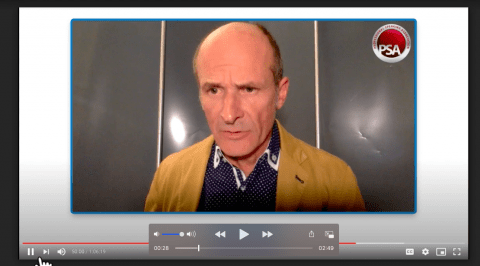Let’s start with the good news. Virtual conferences can put you and your business in front of national and international audiences who you’d never imagine connecting with before. And nobody faces jet-lag the next day, or stewed coffee in the foyer.
But I suspect you knew that already, which is why you’re reading this.
What you probably also know is that virtual conferences throw up a very different set of challenges from the face-to-face in a fancy-conference-centre kind. Wifi can be flakey. Tech can go down. But your audience will still be sitting there, waiting, patiently.
I’ve had the privilege of hosting several face-to-face conferences in the past few years, and a couple of virtual events in 2020. One of the most remarkable was the six day — six day — virtual event held by the Professional Speaking Association in October. Talk about a ‘moonshot’. Thanks to inspiring leadership and a yes-we-can approach from the tech team, it punched through several pain barriers to leave everyone punching the air on the Saturday evening. Yes, these things can be done, and they can deliver.
So here’s what I’ve learnt this past virtual year, in the hope that it might help you too.

Er, something’s not right …
1 LOG ON EARLIER THAN YOU THINK YOU NEED TO
You’ll almost certainly need longer than you think to get connected. At one recent conference, my password mysteriously started playing up 25 minutes before I was due ‘on air’, and I needed to reset it. With time in hand, you’ll still be relaxed when you need to step out on stage. But if it’s only twenty seconds since you’ve faced a grid of fuzzy photos and had to select the ones with traffic lights in them — simply to log on — you won’t be very relaxed at all. As a BBC newsreader, I was expected in the studio 20 minutes before we went on air. I’d suggest a similar discipline if you’re broadcasting online.
2. HAVE A BACK-CHANNEL TO THE TECH TEAM
Don’t assume you’ll get straight through to the team running the show from their own laptops. Wi-fi can let you down. Phones, though, generally don’t. Have the phone number and name of the person you may need to contact, and be prepared to use it. Tech teams I’ve worked with have set up WhatsApp groups to keep in touch. But don’t rely on text. In the heat of a last-minute tech hitch, texts and WhatsApps can so easily be missed. A ringing phone cannot.

Okay, I’ve got this …
3. USE CHAT
Let’s say you’ve slipped elegantly into position ready to introduce the next speaker, but the next speaker has not yet slipped elegantly into position ready to deliver their talk. (It’s happened to me twice.) I recommend here reaching for the Radio Host Ripcord Approach: ask the audience. Radio presenters are quite used to filling for time by asking questions, reading out texts, engaging with the listeners. The Virtual Online solution? Use chat. When the guest I was meant to be introducing recently failed to show up because of technical problems from his home in Amsterdam, I had a bit of fun asking audience members to send me their thoughts on the conference so far via the Chat function. We got a little debate going about online networking, and Top Takeaways. It was all quite jolly.
4. PRINT SOMETHING OUT
I learnt this from a brutal experience in a BBC TV studio once. The autocue failed, so I reached for my emergency — printed out — list of web addresses the public could use to contact the newsroom, keep up to date with the latest news, etc. But alas, I had forgotten to bring it into the studio with me! So it was just me on my lonesome in a silent studio with a dead autocue. The equivalent in the Virtual Conference world is to print off something you can usefully read out. A list of what’s coming up later that day? Some web addresses so that participants can find the handouts from the talks? How to join in the Prize Auction that evening? Anything at all that will give you something to talk about — that you can smilingly reach for. You really don’t want to be scrambling around to find links on your laptop when the laptop is your lifeline to your audience.

Well we got there!
5. AND FINALLY … REMEMBER EVERYONE’S ON YOUR SIDE
Yes, you want to look and sound professional. Yes, the audience are there to hear from the speaker and not from you. But I think it’s okay to realise that audiences are generally fairly forgiving over tech hitches as we all get to grips with our new virtual world. It’s okay to be a bit playful. Explain what’s going on — explain that you’re making it up a bit as you go along. On a news bulletin, the worst ‘look’ is the nonchalant pretence that implies the audience are too foolish to realise there’s a problem. Be playful. Have fun with it. You may find they enjoy you as much as the speaker who — eventually — follows you.
If you’re thinking of hosting an virtual event, and would like a safe-pair-of-hands at the helm … who can draw upon thirty years’ experience of BBC broadcasting if things go wrong … give me a call. Or if you have your host sorted, but would just like some free advice, give me a call anyway. I’m always happy to help!